QDR: Air Force Circles Wagons Around F-35; No Big Push For Drones
Posted on
WASHINGTON: The head of the Air Force’s Quadrennial Defense Review office made very clear today that the service will do all it can to protect the F-35 for a pretty compelling reason: “We must be able to project power in contested environments (A2/AD) and the Joint Strike Fighter is that machine.”
Kwast told reporters after his public remarks that JSF “plays a critical role in an architecture that keeps us ahead of our enemy.” It’s not like previous aircraft that specialized in providing one primary capability.
When I asked him what the Air Force would do if the White House ordered cancellation of the F-35, Kwast offered a pretty standard military response: “What we would do is, if they were to make that decision, we would roll up our sleeves and find a way.” But all his comments made clear that would not be a good idea in the estimation of the Air Force.
During an appearance at the Center for Strategic and International Studies, Maj. Gen. Steven Kwast offered what sounded like one of the service’s bumper stickers as it enters the QDR and 2015 budget battles. The Air Force must be able to react “at the speed of this world,” a capability “only the Air Force provides.” For example, if something happens in the South China Sea (umm China, maybe?), Kwast said the nation needs to be able to respond quickly and effectively. He made pretty clear that he didn’t mean a carrier group steaming over in a few days or weeks.
Kwast was asked if we might expect to see a push in the service to move more forcefully to a force dominated by drones (or, as the Air Force prefers to call them, Remotely Piloted Aircraft). Short answer: no. Long answer: “Does it really bring us a good bang for the buck? If so, we forge ahead.” But drones aren’t a panacea for either savings or capabilities at this point and the Air Force will simply decide what approach works best for each system and combination of systems (He didn’t say this, but Long Range Strike comes to mind as an example).
In other news, the chart above offers a handy short form presentation of the current state of the F-35 on Capitol Hill. It also makes pretty clear how divorced the appropriations bills are from reality this year, because they don’t include sequestration. Winslow Wheeler, defense budget expert at Project for Government Oversight, prepared the chart. Here’s his take on what the appropriators really mean:
“Two things are notable in these reductions: first, while both committees’ actions have been publicly known for a while (and for even longer in DOD), they have not prompted howls of protest from DOD’s chief F-35 advocates, Frank Kendall and Lt. Gen. Bogdan. It is probably safe to assume that the reductions, including the lesser increase for F-35 production in 2015, were both pre-notified to DOD and tacitly—if not explicitly—agreed to. (It may even be that some, if not all, of the cuts were quietly suggested by DOD; that would hardly be the first time.)
“Second, none of these numbers accommodate sequestration. The 2013 sequester has already removed over $800 million from 2013 F-35 procurement (in addition to the approximate $400 million in various congressional cuts for 2013). Moreover, despite speculation that five to ten (more likely the later) aircraft will fall out of the 2013 buy, DOD has refused to say how many. Unless budget-bargaining lightning strikes, there will also be a sequester in 2014. Given the disruption to the program in 2013 resulting from the sequester, which DOD has not yet acknowledged, the impact on the 2014 buy is very difficult to predict. In any case, the expectation of 29 F-35 purchases in 2014 and from 36 to 42 in 2015 is looking more and more fanciful. Budget realities—always an ‘unpredicted’ source of unit cost growth—are settling into the F-35 program.
“While the HAC report had virtually no text addressing the F-35, which probably explains why its cuts have been generally ignored, the SAC report makes some interesting statements.
“Perhaps the most interesting SAC report language is its tacit acknowledgement of a major source of F-35 cost increases, even if the committee does not explicitly recognize it. Page 8 of the report makes reference to the Block 4 capabilities of the F-35 in a ‘follow-on development program’ costing at least $3.8 billion. It is not made clear that this cost is not now a part of DOD’s Selected Acquisition Report (SAR) cost estimate for the F-35 and should be considered an additional F-35 expense. The report also refers to the B61 nuclear bomb capability yet to be integrated and costed into the F-35 program as another additional F-35 cost—heretofore not included in the SAR estimate. The report does not specify the cost of the B61’s integration, but it does state that it will cost $10 million just to assess that integration. Thus, while the SAC committee report does regurgitate some DOD happy-talk about cost (eg.: the F-35 ‘remains on a positive trend of reducing concurrency costs’) the report also reveals at least one of the sources of additional costs—both concurrency and generic—in the form of a heretofore unspecified additional development program costing something in excess of $3.8 billion. Not now a part of the SAR’s estimate of F-35 costs, these are nonetheless as real F-35 costs as anything in the SAR and should be included.”
Subscribe to our newsletter
Promotions, new products and sales. Directly to your inbox.

